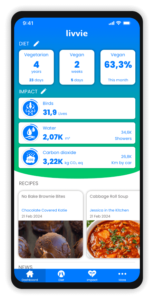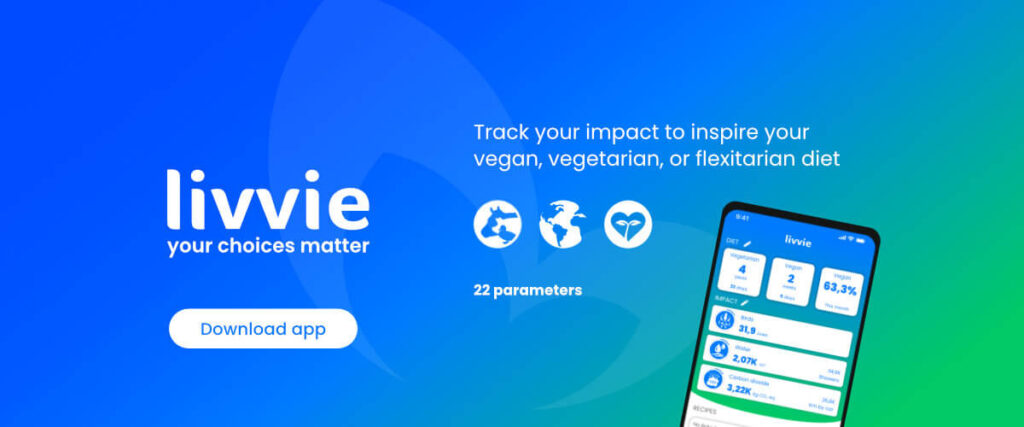How Reduced Land Use With a Vegan Diet Helps the Environment
Published 29 September 2023
As humans, we depend on land to live on and grow food. We have already claimed half of available land for agriculture with vast consequences for the environment and our food supply.
Animal agriculture claims an excessive amount of land due to its inefficiency. To feed future generations and leave them a viable planet, we need to change our lifestyle. In this article, you will learn why we use so much land, what the effects are on the environment, and how you can reduce your land use with a vegetarian or vegan diet.
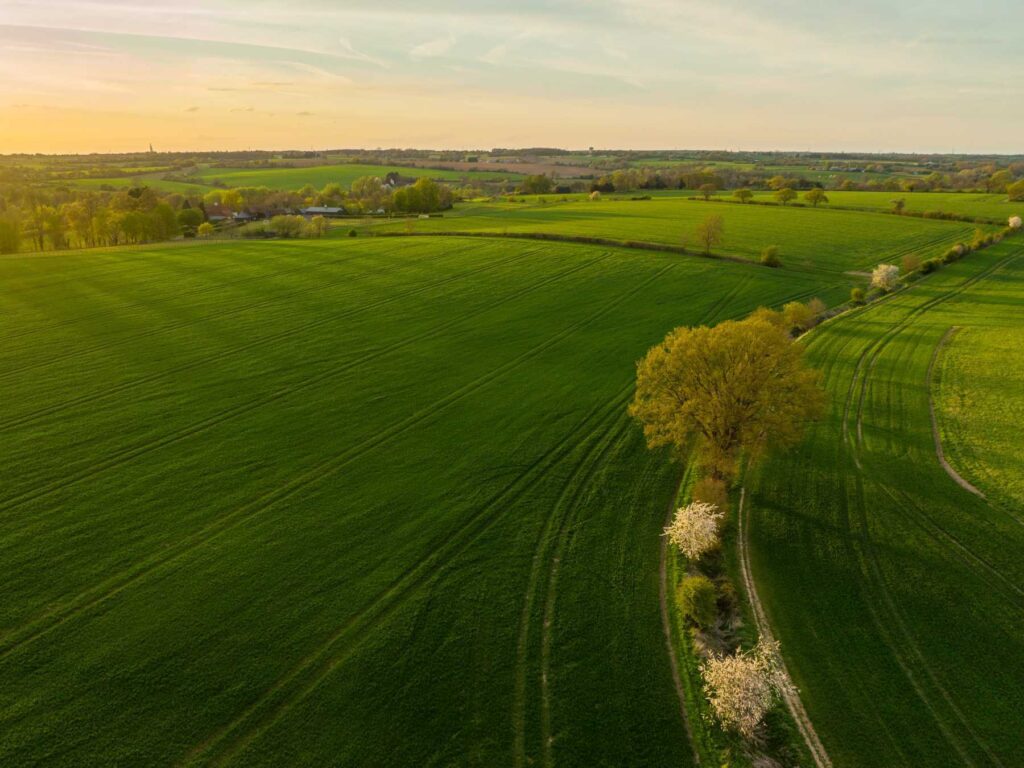
Track how much land and forest you save with the Livvie app
How Much Land Do We Use for Food Production?
Our population has grown rapidly since the Industrial Revolution in the 18th century when there were ‘only’ 1 billion people. We grew to 2,5 billion in 1950 and to 8 billion people today, with most growth happening in developing countries. Predictions state that we will reach around 10 billion people by 2050 and we may reach a peak mid-2080s.
To house and feed everyone, we depend on land, an essential but finite natural resource. Earth’s surface is 510 million km2 in total and consists for 29% of land. Only 71% of that land is habitable and arable with the remaining land consisting of glaciers and barren land such as deserts.
We use only 1% of habitable land to build housing and infrastructure. But to feed all of us, we have already claimed half of Earth’s habitable land for agriculture, or 51 million km2. An excessive 77% of that agricultural land is used for livestock farming. This land use for animal agriculture is disproportionately high considering that meat, fish, dairy, and eggs only provide 18% of global calorie supply.
Clearing all that land for crops and grazing has several consequences for the environment and climate, that ultimately threaten our food supply.
Why a Vegan Diet Uses Less Land
The reason that a vegan diet uses less land than a meat-based diet is the inefficiency of livestock farming. Farm animals need to eat, a lot, so we grow crops to produce animal feed. Just like us, animals use the energy from their food not only to grow but to keep them alive by sustaining their basal metabolism.
This means that a lot of energy and nutrition from food is wasted and not converted into the end-products meat, fish, dairy, or eggs. The amount of food, calories, and protein wasted by animal food products is shown in the table below.
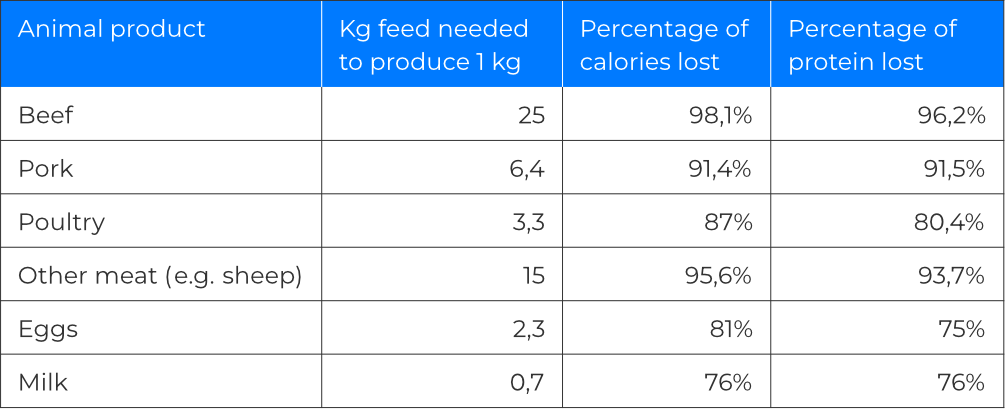
Conversion efficiency of feed into the animal products meat, dairy, and eggs. Adapted from Alexander et al., 2016.
The inefficient conversion of plant-based feed into animal-based products is the reason why 43% of all cropland is used to grow crops for animal feed. Cows use the most land partly because they are the most inefficient energy converters, using 25 kilograms of crops to produce 1 kilogram of beef.
Cows and sheep not only use a lot of land due to inefficient feed conversion, but also because they use even more land for grazing. In fact, 70% of agricultural land is used as grazing pastures although they only provide 9% of beef and 30% of sheep and goat meat.
Not surprisingly, a vegetarian diet uses 64% less land and a vegan diet uses 75% less land than a meat-heavy diet.
Lower Land Use of a Vegan Diet Protects Food Security
When you follow a vegan diet, you consume crops directly or after processing into plant-based food products. When you eat meat or other animal products, you indirectly consume a lot of crops that were fed to farm animals.
The inefficient processing of feed into animal food products such as meat causes food waste on a massive scale. For example, during the conversion of plants to beef, 98% of calories and 96% of protein are lost.
This inefficiency is also the main reason for the massive environmental footprint of animal agriculture, which puts pressure on our food supply. We have already reached the limits of our planet’s natural resources and cannot afford to claim more land for agriculture.
This provides a challenge if we stick to our current diets because we need to feed 10 billion people in a few decades. Yet, with 8 billion people we already fail to provide proper nutrition to everyone. In 2022, 29% of the world population (2,3 billion people) faced food insecurity and 828 million people experienced hunger. Every year 9 million people even die from hunger.
The land that we use to grow crops to feed 31 billion farm animals could also be used to grow crops for direct human consumption. This would help fight world hunger and make land available to restore nature, biodiversity, and capture greenhouse gases to reduce climate change.
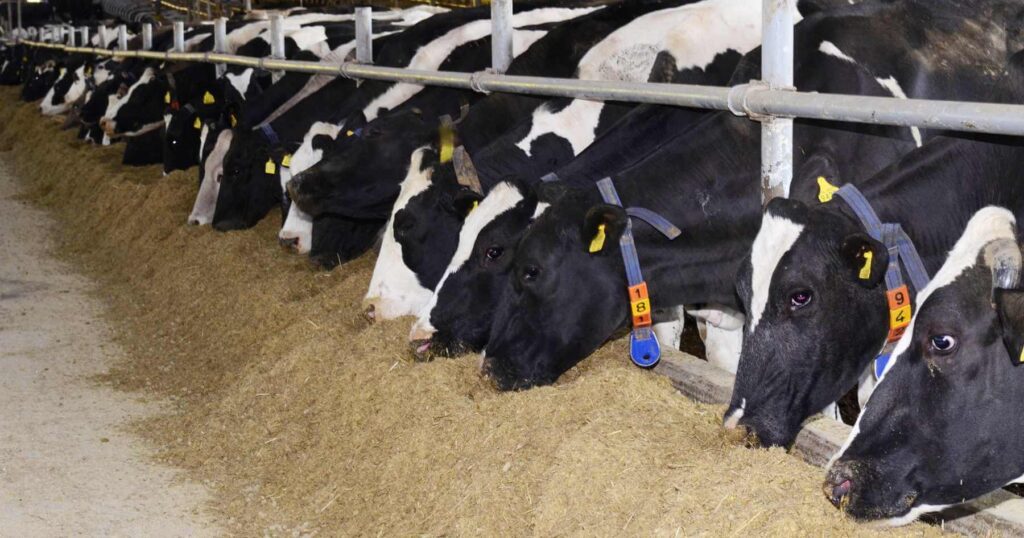
Effects of Land Use on the Environment
By using half of Earth’s habitable land for agriculture, we have disrupted the natural ecosystems that maintained a delicate balance between vegetation and wildlife. Both the vast amount of land and how we use the land for agriculture has drastic consequences for the environment in several ways.
1. Deforestation
To use land for growing crops we have to remove its natural vegetation. Already 46% of Earth’s land that used to be covered by forests, grasslands and bushes is used for agriculture today.
We have destroyed 2 billion hectares (one-third) of Earth’s forest cover throughout history. And we continue that destruction, losing 5 million hectares of forest per year or 13 football (soccer) fields every minute.
Our food system causes 80% of deforestation, led by the demand for beef due to its excessive need for cropland and grazing pastures. Indeed, animal agriculture is driving 91% of deforestation in the Amazon rainforest.
Grazing has a much lower environmental impact than cropland and can happen on grasslands and other land that is not suitable for crops. Unfortunately, there is not enough grazing land on Earth to meet the global demand for meat and dairy. That is why clearing land for cattle grazing pastures and feed production is a main driver of deforestation in the tropics.
Soy has a bad reputation as a driver of deforestation. However, pointing the finger at tofu-eating vegetarians and vegans would be a mistake. Only 19% of all soy is consumed by humans and 77% of all soy is fed to animals. Particularly the soy grown in South America is almost exclusively used as livestock feed.
2. Biodiversity loss
Biodiversity of plants and animal species is essential to maintain a balance in local and global ecosystems. This balance preserves natural resources such as healthy soil and fresh water and preserves the resilience of the environment and our food system.
By claiming land for agriculture and replacing abundant vegetation with a single crop, we disrupt natural habitats for plants and wildlife.
Unfortunately, our appropriation of land for agriculture has already cause the extinction of many animal and plant species. Agriculture continues to threaten 86% of the 1 million species currently at risk of extinction.
Today, wild mammals only make up 6% of mammal biomass, and humans (36%) and livestock (59%) the rest.
Tropical forests are particularly rich in wildlife and biodiversity and thus crucial to preserve. Concerningly, 95% of deforestation happens in delicate tropical forests, mainly driven by the demand for meat.
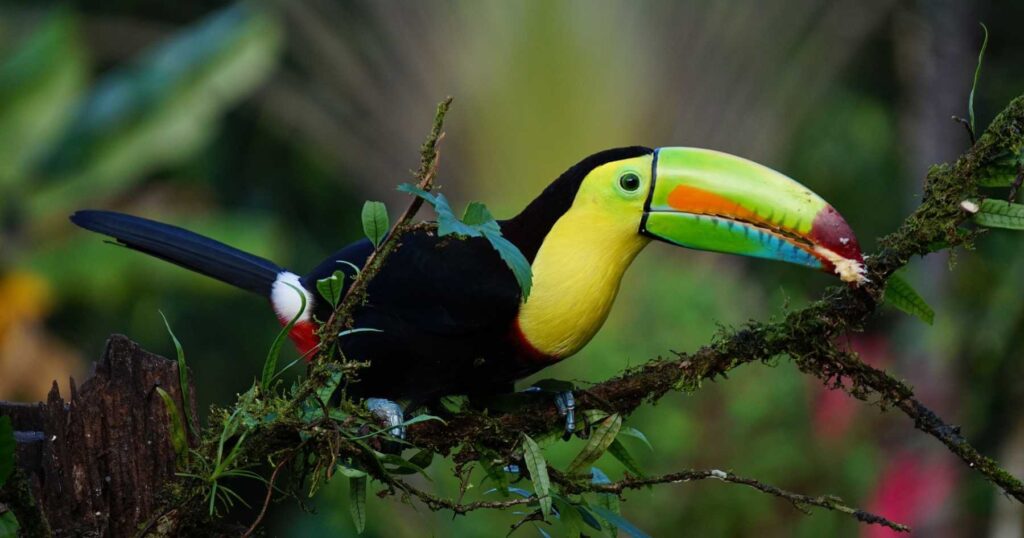
3. Greenhouse gas emissions
Climate change is an existential threat to all life on Earth and already affects the environment, human health, and our economies. Global warming causes extreme weather events, rising sea levels, and shifting ecosystems. Our current policies may even put one-third of the population in uninhabitable climates.
Carbon dioxide is the main driver of climate change, responsible for 76% of greenhouse gas emissions.
Plants and trees capture carbon dioxide from the atmosphere through photosynthesis and form an enormous carbon store. Removing vegetation to clear land for agriculture releases this carbon dioxide and contributes to climate change.
Especially replacing the abundant vegetation of forests by a single crop or grazing pasture causes a large net positive emission of carbon dioxide. Deforestation is largely driven by animal agriculture due to its high land use and contributes to 12% of all greenhouse gas emissions.
Climate change itself impacts our agricultural lands and food supply through flooding, droughts, and desertification.
Forests can play an important role as a solution against global warming by capturing excess carbon dioxide from the atmosphere. By shifting to a primarily plant-based diet, we can make land available to restore nature and fight climate change.
4. Soil degradation
Our food system depends on more than the availability of land surface, but also the quality of the soil. Healthy soil is crucial to get high crop yields. Ironically, the agricultural practices that enabled intensification and more efficient food production are now compromising soil fertility, food supply, and livelihoods of farmers.
Healthy soils are rich in biodiversity, provide nutrients, and regulate water flow. Agriculture has exhausted soils by removing vegetation and micro-organisms through tillage and pesticides. This has depleted essential nutrients, reduced water buffering capacity, and has made agricultural soils susceptible to erosion.
Animal agriculture has a relatively big impact on soil fertility because of its inefficiency. The high need for land to grow crops for livestock feed amplifies its contribution to soil degradation. Grazing has a lower environmental impact on soil than monocultures but can also be damaging if not managed sustainably.
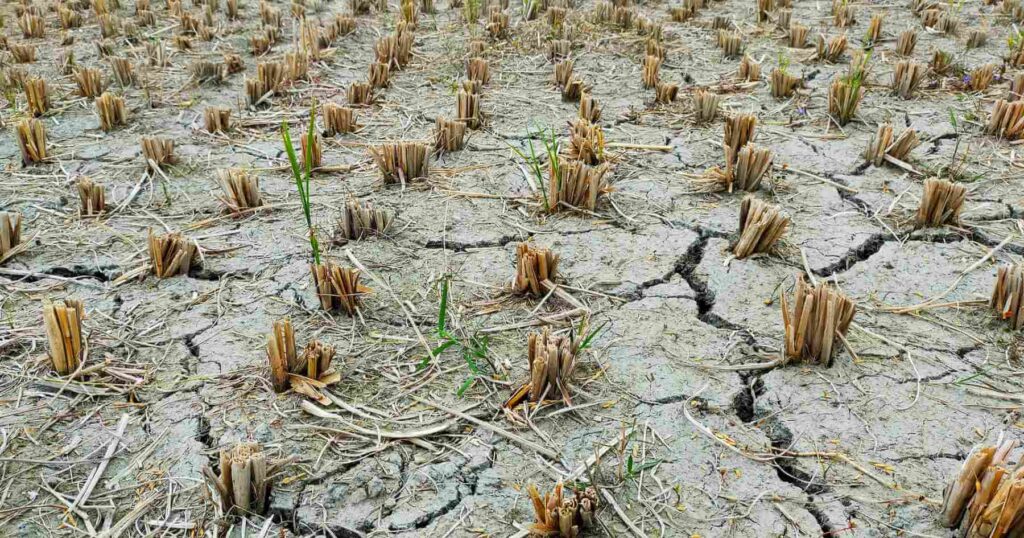
5. Environmental pollution
Besides removing vegetation and wildlife from the lands, agriculture also pollutes soil and surrounding ecosystems.
For decades, we have compensated a lack of nutrients in soils with fertiliser, causing further environmental damage. Fertiliser is rich in nitrogen and phosphorus that pollute surrounding freshwater resources and cause eutrophication. Nitrogen can also be converted by soil bacteria into nitrous oxide, a greenhouse gas that contributes to climate change. Animal agriculture is responsible for 65% of human nitrous oxide emissions.
Monocultures are very susceptible to pests and often depend on the use of pesticides. These pesticides can kill many organisms in the soil and may end up in surrounding ecosystems, posing a risk for wildlife and humans.
Manure from livestock on pastures or used as fertiliser contains nutrients, but also microbes, heavy metals, and medication residues such as antibiotics. Animal waste therefore has additional effects on the environment and possibly human health.
A Vegan Diet Lowers Land Use and Protects the Environment
Agricultural intensification has enabled our accelerated population growth over the past centuries. It has created a more efficient food system, requiring a lot less land to produce a similar amount of food for a lower price.
However, by increasing accessibility to cheap food, demand has increased due to population growth and changing lifestyles. Mostly the increased demand for meat has a massive impact on the environment due to its high land use.
To ensure future generations have food and a viable planet to live on, we need to change our lifestyles. A global shift to a predominantly plant-based diet is essential to protect the environment and reduce climate change.
With a vegan diet, we can reduce agricultural land use by 75%, or the size of North America and Brazil combined. Most of this effect is already accomplished by just ditching red meat and dairy.
This would make land available to restore wildlife habitats and biodiversity. By restoring forests, we would also capture carbon dioxide from the atmosphere to fight climate change. Besides lowering your environmental footprint, you would also make land available to feed people and prevent hunger.
You can calculate how much land and forest your diet saves by downloading our free app.
Inspire others by sharing this article!
Track Your Impact
Inspire your vegetarian or vegan food choices by calculating your impact on 22 parameters.
